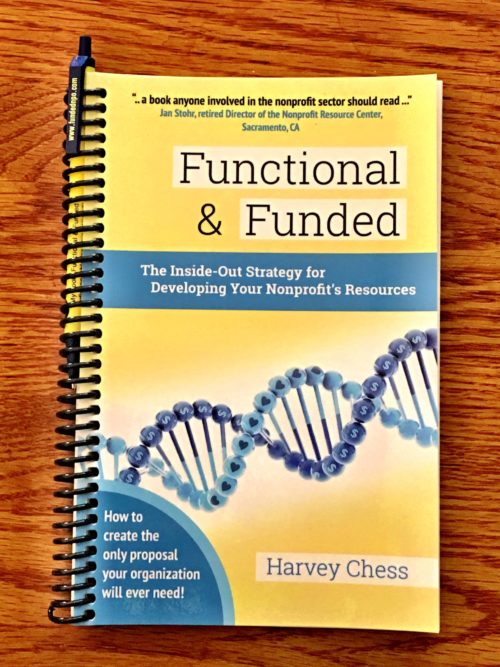The author says:
This nonfiction book was put together and published through Bookbaby within the last year. It deals with the imperative to pursue operating resources that persists among most nonprofit organizations in the public and private sectors. Featured is a strategic combination of “business as unusual” along with often equally unusual common sense, derived from the author’s years as an acclaimed trainer among nonprofits. It is a workbook, if you will, for anyone in or around nonprofit fundraising, and that’s a passel of people.
Nathan says:
It looks great to me — professional, on-topic, business-like.
If I were forced to come up with suggestions, I’d have these two:
- Is there a possibility that potential readers will see the DNA and assume it’s a science book? I don’t know that it’s a great danger, but as a possibility…
- “How to create the only proposal your organization will ever need!” I’m not a non-profit guy, so maybe your potential readers will know exactly what kind of “proposal” you mean, but it seems a little vague to me.
Other comments?


I was also thrown by the DNA graphic. I assumed it was a handbook for research scientists on how to apply for and get research grants.
Other than that, it looks good. Clear, crisp, professional appearance. And it works at thumbnail size too.
I’m a little bit confused about the image itself: is this the cover of the book, or a photograph of your book as currently published? A front cover showing a photograph of the book’s first edition might have a strange kind appeal for advertising that this book is now on its second edition, but such a gimmick probably isn’t particularly necessary. Either way, your first edition is nicely done.
I’ll second the other critics’ confusion over the symbolism of the DNA; sure, if you look closely, you’ll see the hearts and dollar signs printed on it, but one’s first impression is that this book probably has something to do with biology and specifically genetics. Combine that with the title, and until you look really closely, it would seem to be a book about how to get your backers to shake loose enough cash to allow your research lab to finish that retro-viral cure for cancer that you’ve been developing (or some such). What kind of nonprofit organizations are we talking about here?
In short, the layout’s good, but you might want to pick a different symbol to represent your target audience’s nonprofits unless they really are all genetic research labs.
I think the photograph-of-a-cover cover is a silly gimmick, but it’s nicely executed here.
The symbols on the DNA strands would stand out more if there was more contrast; maybe try making the symbols white?
I have to join the camp questioning the DNA image. One has to look closely to see the hearts and dollar signs…but many may not make that effort. And even then, the significance of the DNA molecule is elusive. Covers should not be visual puzzles. They need to be read and understood immediately.
Other than that, it’s a good, workman-like design.
I the DNA image is fine. I expect instructional books on abstract topics to have non-indicative cover images, like that line of programming books with the animal drawings on them. I would never look at this and mistake it for a genetics book.
” I would never look at this and mistake it for a genetics book.”
One test for a book cover is to imagine the title and other text in a language you do not know. If it is still clear what the book is about or what kind of book it is, then the cover works. I think if you were to imagine this cover in an unfamiliar language, the prominent DNA imagery might indeed be misleading.
That test doesn’t work for abstract topics. There’s no image you could put on a cover that would clearly say “nonprofit funding.”
The actual cover for sale is not a photograph on a table of the cover.
Just so everyone knows.
I’m in the DNA doesn’t work camp. Yes, it may be that there are no images that say “nonprofit funding” … but using that basic logic you could put or horse, a space shuttle, or a bloody cleaver on the cover.
There are, however, concepts that would be more appropriate, such as money, or forms, or even pure abstract like fractals. IMHO – Using the DNA say’s “science”.
Otherwise, very nice looking cover.
Kindly,
Tamian
Cover Designer